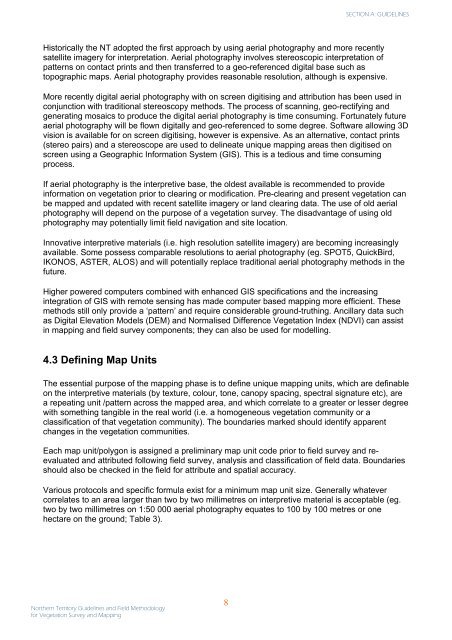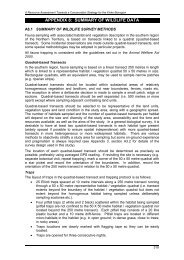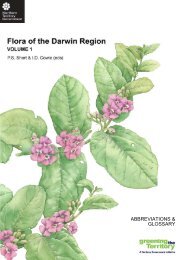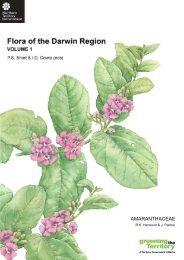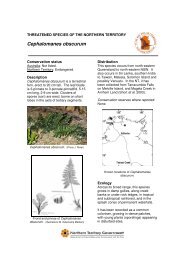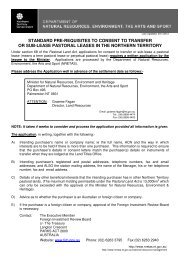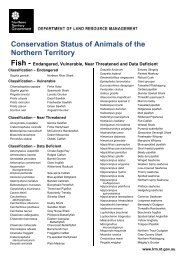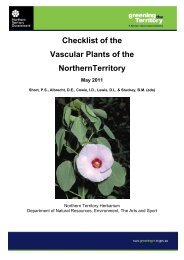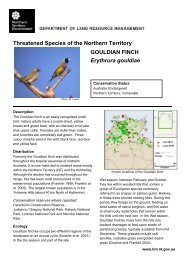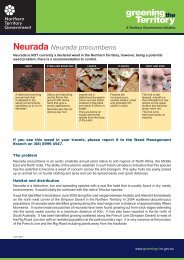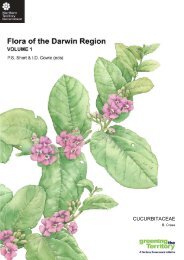Guidelines and Field Methodology for Vegetation Survey and Mapping
Guidelines and Field Methodology for Vegetation Survey and Mapping
Guidelines and Field Methodology for Vegetation Survey and Mapping
Create successful ePaper yourself
Turn your PDF publications into a flip-book with our unique Google optimized e-Paper software.
SECTION A: GUIDELINES<br />
Historically the NT adopted the first approach by using aerial photography <strong>and</strong> more recently<br />
satellite imagery <strong>for</strong> interpretation. Aerial photography involves stereoscopic interpretation of<br />
patterns on contact prints <strong>and</strong> then transferred to a geo-referenced digital base such as<br />
topographic maps. Aerial photography provides reasonable resolution, although is expensive.<br />
More recently digital aerial photography with on screen digitising <strong>and</strong> attribution has been used in<br />
conjunction with traditional stereoscopy methods. The process of scanning, geo-rectifying <strong>and</strong><br />
generating mosaics to produce the digital aerial photography is time consuming. Fortunately future<br />
aerial photography will be flown digitally <strong>and</strong> geo-referenced to some degree. Software allowing 3D<br />
vision is available <strong>for</strong> on screen digitising, however is expensive. As an alternative, contact prints<br />
(stereo pairs) <strong>and</strong> a stereoscope are used to delineate unique mapping areas then digitised on<br />
screen using a Geographic In<strong>for</strong>mation System (GIS). This is a tedious <strong>and</strong> time consuming<br />
process.<br />
If aerial photography is the interpretive base, the oldest available is recommended to provide<br />
in<strong>for</strong>mation on vegetation prior to clearing or modification. Pre-clearing <strong>and</strong> present vegetation can<br />
be mapped <strong>and</strong> updated with recent satellite imagery or l<strong>and</strong> clearing data. The use of old aerial<br />
photography will depend on the purpose of a vegetation survey. The disadvantage of using old<br />
photography may potentially limit field navigation <strong>and</strong> site location.<br />
Innovative interpretive materials (i.e. high resolution satellite imagery) are becoming increasingly<br />
available. Some possess comparable resolutions to aerial photography (eg. SPOT5, QuickBird,<br />
IKONOS, ASTER, ALOS) <strong>and</strong> will potentially replace traditional aerial photography methods in the<br />
future.<br />
Higher powered computers combined with enhanced GIS specifications <strong>and</strong> the increasing<br />
integration of GIS with remote sensing has made computer based mapping more efficient. These<br />
methods still only provide a ‘pattern’ <strong>and</strong> require considerable ground-truthing. Ancillary data such<br />
as Digital Elevation Models (DEM) <strong>and</strong> Normalised Difference <strong>Vegetation</strong> Index (NDVI) can assist<br />
in mapping <strong>and</strong> field survey components; they can also be used <strong>for</strong> modelling.<br />
4.3 Defining Map Units<br />
The essential purpose of the mapping phase is to define unique mapping units, which are definable<br />
on the interpretive materials (by texture, colour, tone, canopy spacing, spectral signature etc), are<br />
a repeating unit /pattern across the mapped area, <strong>and</strong> which correlate to a greater or lesser degree<br />
with something tangible in the real world (i.e. a homogeneous vegetation community or a<br />
classification of that vegetation community). The boundaries marked should identify apparent<br />
changes in the vegetation communities.<br />
Each map unit/polygon is assigned a preliminary map unit code prior to field survey <strong>and</strong> reevaluated<br />
<strong>and</strong> attributed following field survey, analysis <strong>and</strong> classification of field data. Boundaries<br />
should also be checked in the field <strong>for</strong> attribute <strong>and</strong> spatial accuracy.<br />
Various protocols <strong>and</strong> specific <strong>for</strong>mula exist <strong>for</strong> a minimum map unit size. Generally whatever<br />
correlates to an area larger than two by two millimetres on interpretive material is acceptable (eg.<br />
two by two millimetres on 1:50 000 aerial photography equates to 100 by 100 metres or one<br />
hectare on the ground; Table 3).<br />
Northern Territory <strong>Guidelines</strong> <strong>and</strong> <strong>Field</strong> <strong>Methodology</strong><br />
<strong>for</strong> <strong>Vegetation</strong> <strong>Survey</strong> <strong>and</strong> <strong>Mapping</strong><br />
8


